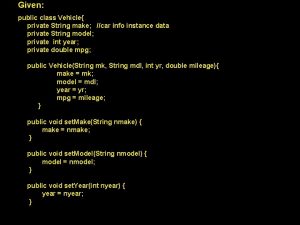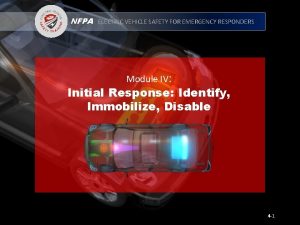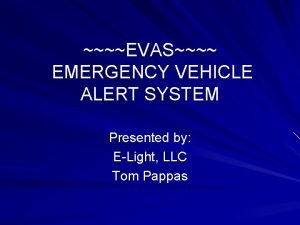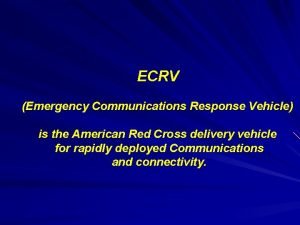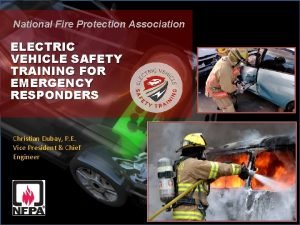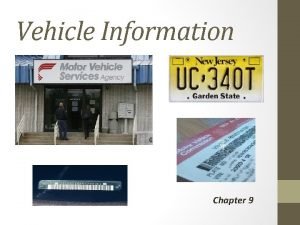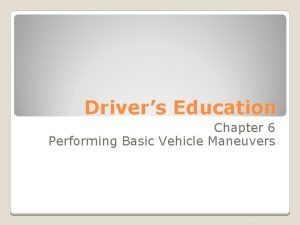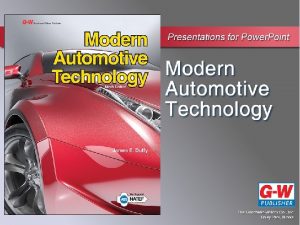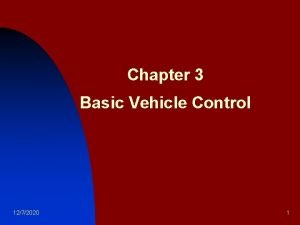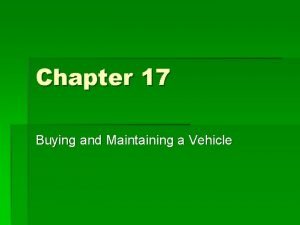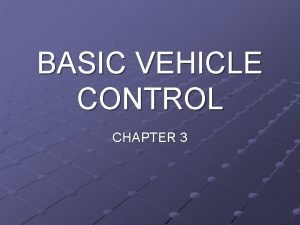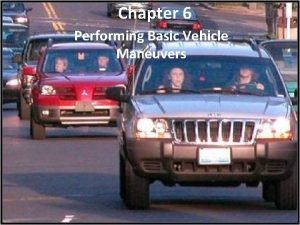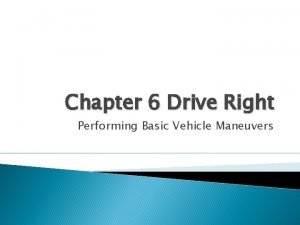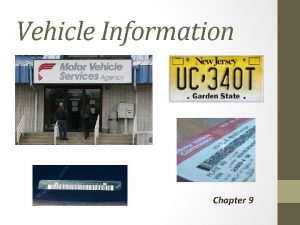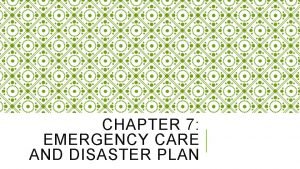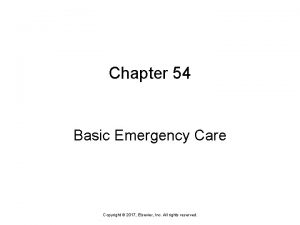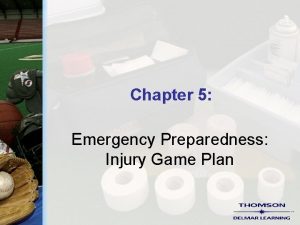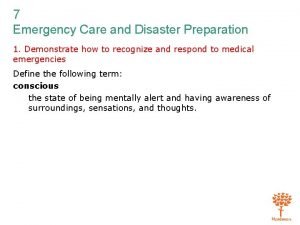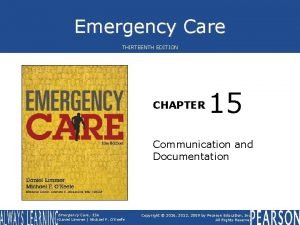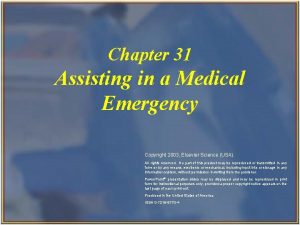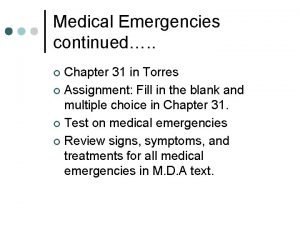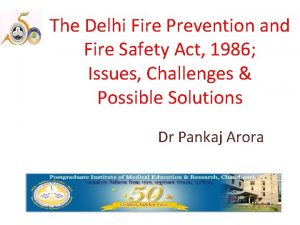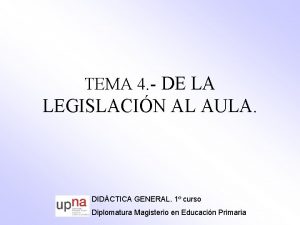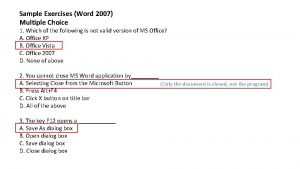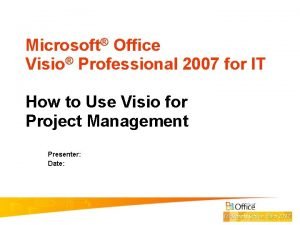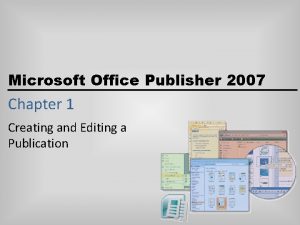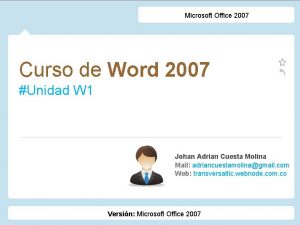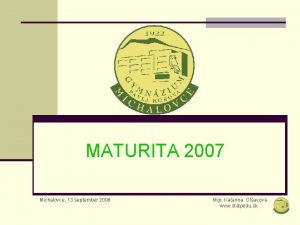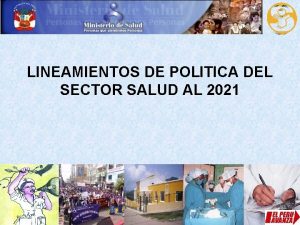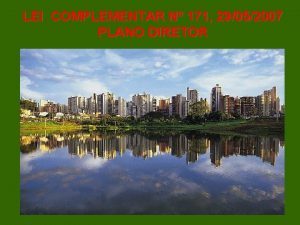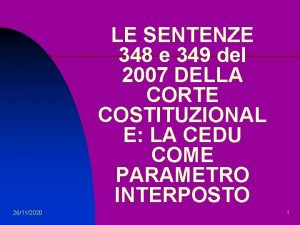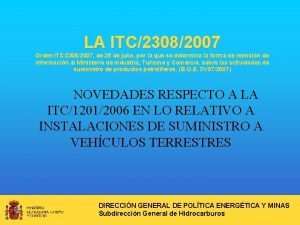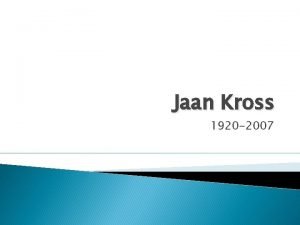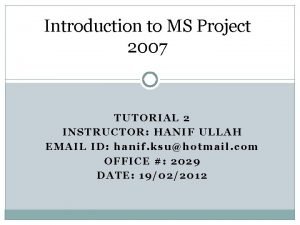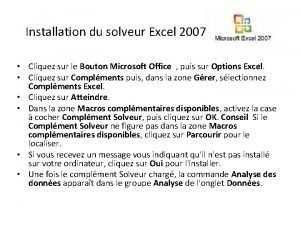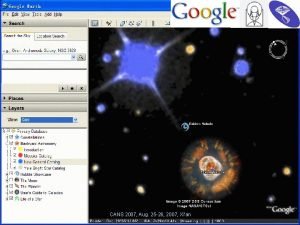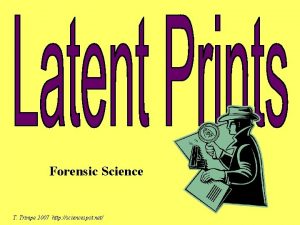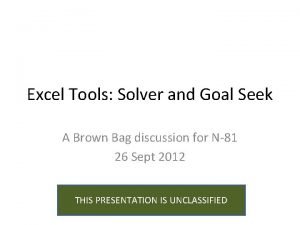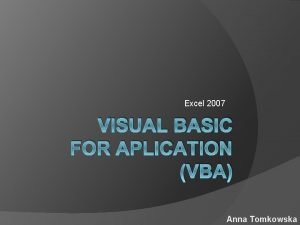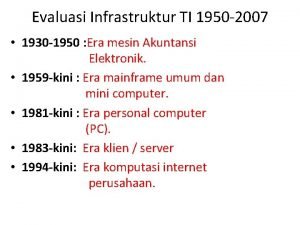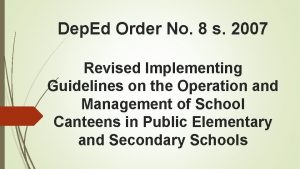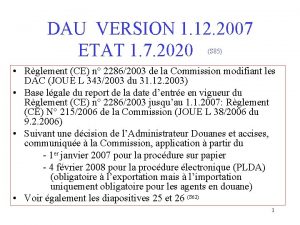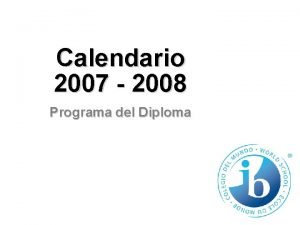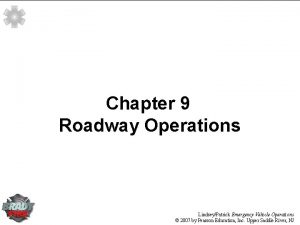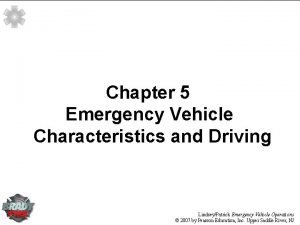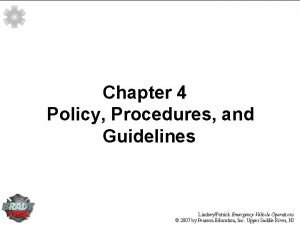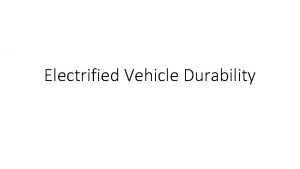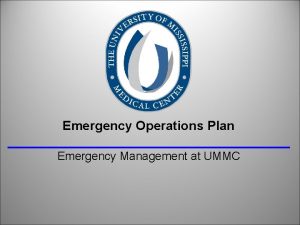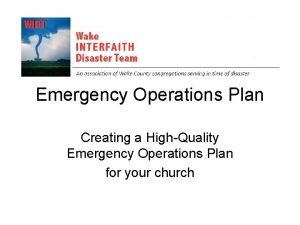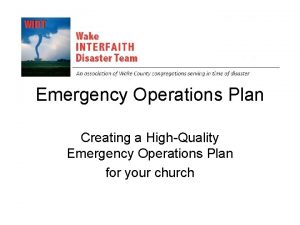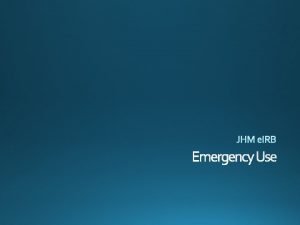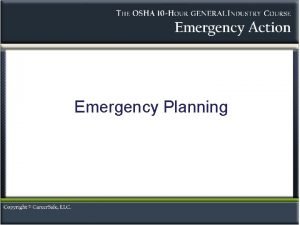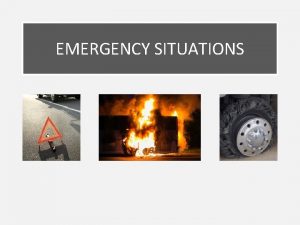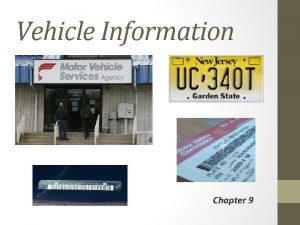Chapter 6 Operations LindseyPatrick Emergency Vehicle Operations 2007












































































- Slides: 76

Chapter 6 Operations Lindsey/Patrick Emergency Vehicle Operations © 2007 by Pearson Education, Inc. Upper Saddle River, NJ

Objectives Describe the SIPDE acronym as it relates to controlling the emergency vehicle. Describe how to select an appropriate route to respond to an incident. Discuss the various components associated with an emergency response. Describe the various types of adverse conditions. Lindsey/Patrick Emergency Vehicle Operations © 2007 by Pearson Education, Inc. Upper Saddle River, NJ

Objectives Discuss the use of seat belts. Describe the use of preemption systems. Explain the use of Black Box technology in emergency vehicles. Discuss GPS and GIS systems. Explain how to avoid crashes. Lindsey/Patrick Emergency Vehicle Operations © 2007 by Pearson Education, Inc. Upper Saddle River, NJ

Case Study Review and discuss the case study. Lindsey/Patrick Emergency Vehicle Operations © 2007 by Pearson Education, Inc. Upper Saddle River, NJ

Introduction Lindsey/Patrick Emergency Vehicle Operations © 2007 by Pearson Education, Inc. Upper Saddle River, NJ

More Than Just Driving Lindsey/Patrick Emergency Vehicle Operations © 2007 by Pearson Education, Inc. Upper Saddle River, NJ

Principles of Defensive Driving Predicting the unpredictable Expect the unexpected Handle any unexpected problems Lindsey/Patrick Emergency Vehicle Operations © 2007 by Pearson Education, Inc. Upper Saddle River, NJ

SIPDE Scan Identify Predict Decide Execute Lindsey/Patrick Emergency Vehicle Operations © 2007 by Pearson Education, Inc. Upper Saddle River, NJ

Five Visual Habits of Defensive Driving Aim high in steering (look at least 15 seconds ahead of your vehicle). Get the big picture. Keep eyes moving, scan. Make sure other drivers see the emergency vehicle. Identify an escape route. Lindsey/Patrick Emergency Vehicle Operations © 2007 by Pearson Education, Inc. Upper Saddle River, NJ

More Than Just Driving Route selection Procedures Lindsey/Patrick Emergency Vehicle Operations © 2007 by Pearson Education, Inc. Upper Saddle River, NJ

Procedures Route planning Geographic and local conditions Lindsey/Patrick Emergency Vehicle Operations © 2007 by Pearson Education, Inc. Upper Saddle River, NJ

Points to Ponder What conditions could you expect in a rural area? Lindsey/Patrick Emergency Vehicle Operations © 2007 by Pearson Education, Inc. Upper Saddle River, NJ

Points to Ponder What conditions could you expect in a rural area? Answer: While driving in rural conditions, you may have to drive on two-lane, dirt, or gravel roads that are poorly marked. Lindsey/Patrick Emergency Vehicle Operations © 2007 by Pearson Education, Inc. Upper Saddle River, NJ

Predetermined Routes Minimize stops and turns Avoid intersections Time of day Avoid residential streets Lindsey/Patrick Emergency Vehicle Operations © 2007 by Pearson Education, Inc. Upper Saddle River, NJ

Driver Familiarization Know your area Daily route information Lindsey/Patrick Emergency Vehicle Operations © 2007 by Pearson Education, Inc. Upper Saddle River, NJ

Driver Familiarization Know your area. Daily route information: – Review the primary and alternate routes. – New developments and buildings under construction. – Limited road and street signs, learn the local references, such as buildings, farms, gas stations, and so on. – Review and learn about different activities that may effect the traffic flow of the route each day. Lindsey/Patrick Emergency Vehicle Operations © 2007 by Pearson Education, Inc. Upper Saddle River, NJ

Points to Ponder Your area has buildings that the driver needs to pay particular attention to everyday. Think of types of buildings that may have scheduled activities in which the driver needs to be aware. Lindsey/Patrick Emergency Vehicle Operations © 2007 by Pearson Education, Inc. Upper Saddle River, NJ

Points to Ponder Your area has buildings that the driver needs to pay particular attention to everyday. Think of types of buildings that may have scheduled activities in which the driver needs to be aware. Some considerations: Schools, hospitals, auditoriums, concert halls, stadiums, factories, churches, shopping centers, and downtown work. Lindsey/Patrick Emergency Vehicle Operations © 2007 by Pearson Education, Inc. Upper Saddle River, NJ

Driver Familiarization Know your area. Daily route information: – Expect delays in high traffic building areas during these times: Beginning and end of normal work and school day Shift-change times for large factories, hospitals, and so on Lindsey/Patrick Emergency Vehicle Operations © 2007 by Pearson Education, Inc. Upper Saddle River, NJ

Driver Familiarization Know your area. Daily route information: – The daily route can be affected by the weather and other environmental reasons: Emergency snow routes Roads closed due to flooding Lindsey/Patrick Emergency Vehicle Operations © 2007 by Pearson Education, Inc. Upper Saddle River, NJ

Driver Familiarization Know your area. Daily route information: – Be aware of the following conditions of local roads and streets: Damage, potholes, and badly rutted roads Expressway utilization policies during rush hour or construction Detours and closed roads Speed bumps, dips, and bumps Areas of standing water Lindsey/Patrick Emergency Vehicle Operations © 2007 by Pearson Education, Inc. Upper Saddle River, NJ

Procedures to Identify Local Information Height restrictions Vehicle clearance Lindsey/Patrick Emergency Vehicle Operations © 2007 by Pearson Education, Inc. Upper Saddle River, NJ

Points to Ponder How to read a map: Obtain and select a section of a local map you are familiar with. Prepare a list of factors that must be considered when planning a route. Use a local map to plan a route from an emergency site to various landmarks. Use the names of real roads, streets, and buildings. Lindsey/Patrick Emergency Vehicle Operations © 2007 by Pearson Education, Inc. Upper Saddle River, NJ

Points to Ponder Factors to consider when planning your route: Indicate the road or street where the entrance to your local medical facility is located. Indicate the road or street where the entrance to the emergency site is located. List any special conditions, street closings, detours, and other factors that would effect the route to the emergency site. Lindsey/Patrick Emergency Vehicle Operations © 2007 by Pearson Education, Inc. Upper Saddle River, NJ

Responses Emergency driving Emergency signaling devices: – Two basic concepts: Notify other drivers that an approaching emergency vehicle is operating in an emergency mode. Require other drivers to yield the right of way to the emergency vehicle in accordance with state and/or local law. Lindsey/Patrick Emergency Vehicle Operations © 2007 by Pearson Education, Inc. Upper Saddle River, NJ

Light Color Recognition RED: Stop BLUE: Emergency vehicles (Fire or Police) AMBER: Danger/Caution CLEAR: Caution Lindsey/Patrick Emergency Vehicle Operations © 2007 by Pearson Education, Inc. Upper Saddle River, NJ

Limitations Involving Emergency Lights Low sun or glare can greatly reduce their effectiveness. At night, red beacons can be confused with traffic lights and neon signs. Lights on emergency vehicles may pass over motorists if the emergency vehicle is close to the rear of the passenger car ahead. Lindsey/Patrick Emergency Vehicle Operations © 2007 by Pearson Education, Inc. Upper Saddle River, NJ

Several Basic Procedures Utilize the siren whenever responding to an emergency Change the mode of the siren from wail to yelp at least 200 feet from entering an intersection High low mode is least effective mode Use another audible device Air horn, use short repetitive blasts Lindsey/Patrick Emergency Vehicle Operations © 2007 by Pearson Education, Inc. Upper Saddle River, NJ

Emergency Driving and Lights Notify other drivers that an emergency vehicle is approaching. Request that the other drivers yield the right of way to the emergency vehicle. Lindsey/Patrick Emergency Vehicle Operations © 2007 by Pearson Education, Inc. Upper Saddle River, NJ

Responses of Other Drivers to Emergency Driving Most drivers will yield the right of way to an emergency vehicle if: – They realize the ambulance is there. – They have sufficient time to make a decision as to what to do. – They have sufficient time and space to carry out that decision. Lindsey/Patrick Emergency Vehicle Operations © 2007 by Pearson Education, Inc. Upper Saddle River, NJ

Operations Response times Speed limits Lindsey/Patrick Emergency Vehicle Operations © 2007 by Pearson Education, Inc. Upper Saddle River, NJ

Local Regulations Governing Use of Lights and Siren Provide local criteria for use of lights and siren. If appropriate, provide local regulations which authorize the driver’s ability to exceed posted speed limits. Lindsey/Patrick Emergency Vehicle Operations © 2007 by Pearson Education, Inc. Upper Saddle River, NJ

Operations Response times Speed limits Controlled intersection procedure Dangers Due regard Lindsey/Patrick Emergency Vehicle Operations © 2007 by Pearson Education, Inc. Upper Saddle River, NJ

Due Regard Was it necessary to use the emergency warning system under the circumstances of the call you were responding to and the medical condition of the patient you were transporting? Did the emergency vehicle driver give enough warning of the vehicle’s approach to allow other motorists and pedestrians to clear the way for the emergency vehicle? Lindsey/Patrick Emergency Vehicle Operations © 2007 by Pearson Education, Inc. Upper Saddle River, NJ

Due Regard Was the emergency warning system activated and operating prior to the crash? Was the emergency vehicle driver using the emergency warning system in the manner for which the system was designed to be used? Lindsey/Patrick Emergency Vehicle Operations © 2007 by Pearson Education, Inc. Upper Saddle River, NJ

Due Regard Was the driver of the emergency vehicle operating the vehicle at a speed greater than necessary to allow the complete control of the emergency vehicle in relation to traffic, road, and weather conditions? Lindsey/Patrick Emergency Vehicle Operations © 2007 by Pearson Education, Inc. Upper Saddle River, NJ

The National Voluntary Consensus Standard The siren should be in the wail mode 300 feet prior to the intersection. Switch the siren to the yelp mode 150 feet prior to the intersection. Lindsey/Patrick Emergency Vehicle Operations © 2007 by Pearson Education, Inc. Upper Saddle River, NJ

The National Voluntary Consensus Standard Remove your foot from the accelerator to cover the brake pedal and allow compression to slow the vehicle. Start applying the brake to bring the emergency vehicle to a complete stop at the crosswalk line. If the emergency vehicle has an air-driven air horn, give two short blasts on the air horn. Make a complete stop. Lindsey/Patrick Emergency Vehicle Operations © 2007 by Pearson Education, Inc. Upper Saddle River, NJ

The National Voluntary Consensus Standard Continue with the siren in yelp mode and proceed through the intersection exercising the highest degree of care. When there are vacant lanes to the left or right, complete the previous steps of clearing each lane of traffic prior to crossing that lane. Lindsey/Patrick Emergency Vehicle Operations © 2007 by Pearson Education, Inc. Upper Saddle River, NJ

The National Voluntary Consensus Standard Other emergency vehicles may be approaching the same intersection Turn right at the intersection only after all vehicles have stopped and drivers on the right are aware of the emergency vehicle. Lindsey/Patrick Emergency Vehicle Operations © 2007 by Pearson Education, Inc. Upper Saddle River, NJ

The National Voluntary Consensus Standard Expect that any vehicles in front may make an unexpected left turn in front of the emergency vehicle after it has started to enter the intersection. Be aware of other hazards at the intersection. Lindsey/Patrick Emergency Vehicle Operations © 2007 by Pearson Education, Inc. Upper Saddle River, NJ

Operations Response times Speed limits Controlled intersection procedure Dangers Due regard Driving against traffic Lindsey/Patrick Emergency Vehicle Operations © 2007 by Pearson Education, Inc. Upper Saddle River, NJ

Adverse Conditions The two types of adverse conditions to discuss affect: – Traction – Vision Lindsey/Patrick Emergency Vehicle Operations © 2007 by Pearson Education, Inc. Upper Saddle River, NJ

Traction Rain Lindsey/Patrick Emergency Vehicle Operations © 2007 by Pearson Education, Inc. Upper Saddle River, NJ

Rain When it rains, a layer of water forms over the road. As a rolling tire moves over this layer of water, it loses contact with the road surface. Hydroplaningis especially dangerous because the driver loses steering and braking control. As little as 1/16 of an inch of water on the road surface can cause hydroplaning. Lindsey/Patrick Emergency Vehicle Operations © 2007 by Pearson Education, Inc. Upper Saddle River, NJ

Rain Driving through large areas of water If water is concentrated on one portion of the road Lindsey/Patrick Emergency Vehicle Operations © 2007 by Pearson Education, Inc. Upper Saddle River, NJ

Rain and Standing Water Slow down before hitting water. Gently apply the brakes for a few moments when exiting the deeper puddles. Lindsey/Patrick Emergency Vehicle Operations © 2007 by Pearson Education, Inc. Upper Saddle River, NJ

Traction Rain Snow and ice High winds Leaves Lindsey/Patrick Emergency Vehicle Operations © 2007 by Pearson Education, Inc. Upper Saddle River, NJ

Increasing Traction with Traction Devices Snow tires Chains Lindsey/Patrick Emergency Vehicle Operations © 2007 by Pearson Education, Inc. Upper Saddle River, NJ

Vision Driving at night Lindsey/Patrick Emergency Vehicle Operations © 2007 by Pearson Education, Inc. Upper Saddle River, NJ

Conditions at Night Darkness conceals hazards and the driver must make decisions based on incomplete information. It is more difficult to judge the speed and position of another vehicle. The driver’s peripheral vision is reduced if he/she smokes. Adequate highway lighting is limited. Glare from roadside lighting and oncoming vehicle headlights impair the driver’s visibility. Lindsey/Patrick Emergency Vehicle Operations © 2007 by Pearson Education, Inc. Upper Saddle River, NJ

Night Driving Techniques Keep dash and panel lights dim for better vision, but always have enough light to read the speedometer. Reduce speed so that you can stop within the visible distance. Lindsey/Patrick Emergency Vehicle Operations © 2007 by Pearson Education, Inc. Upper Saddle River, NJ

Night Driving Increase sight distance by keeping the headlights clean and properly aimed and the windshield clean. Watch beyond the headlights on or near the roadway for slow-moving or unlighted vehicles, curves, T intersections, road obstructions or defects, trains, pedestrians, and animals. Keep your eyes moving so that your blind spot does not hide objects ahead. Lindsey/Patrick Emergency Vehicle Operations © 2007 by Pearson Education, Inc. Upper Saddle River, NJ

Maintaining Night Vision Don’t move immediately from a brightly-lit room to a dark vehicle and begin driving. Avoid looking directly into glaring headlights of oncoming vehicles. Don’t smoke. Don’t wear sunglasses at night. Lindsey/Patrick Emergency Vehicle Operations © 2007 by Pearson Education, Inc. Upper Saddle River, NJ

Vision Driving at night Rain and fog Lindsey/Patrick Emergency Vehicle Operations © 2007 by Pearson Education, Inc. Upper Saddle River, NJ

Rain and Fog Reduced visibility Glare Lindsey/Patrick Emergency Vehicle Operations © 2007 by Pearson Education, Inc. Upper Saddle River, NJ

The Vehicle Windshield and wipers Visors Bug screens Headlights Side view mirrors Lindsey/Patrick Emergency Vehicle Operations © 2007 by Pearson Education, Inc. Upper Saddle River, NJ

The Driver Compensating for visibility problems Lindsey/Patrick Emergency Vehicle Operations © 2007 by Pearson Education, Inc. Upper Saddle River, NJ

Compensating for Visibility Problems Prepare yourself. Get enough sleep and do not drink alcohol before going on duty. Smoking also reduces night vision. Turn on low beam headlights and the wipers, if needed. Never drive with only the parking lights on. Lindsey/Patrick Emergency Vehicle Operations © 2007 by Pearson Education, Inc. Upper Saddle River, NJ

Compensating for Visibility Problems Headlights should be on at all times. Watch for slow-moving and stopped vehicles. Check the side view mirrors frequently for vehicles approaching quickly from the rear. Lindsey/Patrick Emergency Vehicle Operations © 2007 by Pearson Education, Inc. Upper Saddle River, NJ

Compensating for Visibility Problems Be alert for patches of fog in valleys and low-lying areas. Drive slowly, but keep moving. If conditions are too bad to continue, pull over as far as possible, stop, leave lights on, and activate hazard lights. Lindsey/Patrick Emergency Vehicle Operations © 2007 by Pearson Education, Inc. Upper Saddle River, NJ

Seat Belts Restraints Secure equipment Unsafe behavior Lindsey/Patrick Emergency Vehicle Operations © 2007 by Pearson Education, Inc. Upper Saddle River, NJ

Technology Preemption systems Lindsey/Patrick Emergency Vehicle Operations © 2007 by Pearson Education, Inc. Upper Saddle River, NJ

Preemption Systems Emergency vehicles activating a traffic signal preemption system can negotiate an intersection more safely. Traffic in direction of emergency vehicle clears intersection safely. Traffic approaching an intersection where preemption has been activated by an approaching emergency vehicle is safer. Lindsey/Patrick Emergency Vehicle Operations © 2007 by Pearson Education, Inc. Upper Saddle River, NJ

Preemption Systems Patients transported in emergency vehicles will reach their destinations in a more timely and safe manner. More timely response to emergency calls. Lindsey/Patrick Emergency Vehicle Operations © 2007 by Pearson Education, Inc. Upper Saddle River, NJ

Preemption Systems Benefits: – Emergency vehicles activating a traffic signal preemption system can negotiate an intersection more safely – Traffic in direction of emergency vehicle clears intersection safely – Traffic approaching an intersection where preemption has been activated by an approaching emergency vehicle is safer – Patients transported in emergency vehicles will reach their destinations in a more timely and safe manner – More timely response to emergency calls. Lindsey/Patrick Emergency Vehicle Operations © 2007 by Pearson Education, Inc. Upper Saddle River, NJ

Preemption Systems Institutional issues Implementation issues Lindsey/Patrick Emergency Vehicle Operations © 2007 by Pearson Education, Inc. Upper Saddle River, NJ

Technology Preemption systems The Black Box Lindsey/Patrick Emergency Vehicle Operations © 2007 by Pearson Education, Inc. Upper Saddle River, NJ

Black Box The ABCs of Safe. Force™ driving Lindsey/Patrick Emergency Vehicle Operations © 2007 by Pearson Education, Inc. Upper Saddle River, NJ

Technology Preemption systems The Black Box GIS AVL GPS Other technology Lindsey/Patrick Emergency Vehicle Operations © 2007 by Pearson Education, Inc. Upper Saddle River, NJ

Crash Avoidance Techniques Justification Techniques Plan ahead to avoid a crash Lindsey/Patrick Emergency Vehicle Operations © 2007 by Pearson Education, Inc. Upper Saddle River, NJ

Crash Avoidance Techniques Justification Techniques Plan ahead to avoid a crash: – It physically prepares the vehicle for the effects of a crash. – It prepares the driver mentally by making him/her think about avoiding the crash. Lindsey/Patrick Emergency Vehicle Operations © 2007 by Pearson Education, Inc. Upper Saddle River, NJ

Crash Avoidance Techniques Justification Techniques Plan ahead to avoid a crash Securing the equipment Wear seat belts Lindsey/Patrick Emergency Vehicle Operations © 2007 by Pearson Education, Inc. Upper Saddle River, NJ

Crash Avoidance Techniques Mentally prepare yourself Maintain rear and side space cushion Space management Use a backer Lindsey/Patrick Emergency Vehicle Operations © 2007 by Pearson Education, Inc. Upper Saddle River, NJ

Multiple Responding Units/Multiple Agencies Response Clearing a controlled intersection Lindsey/Patrick Emergency Vehicle Operations © 2007 by Pearson Education, Inc. Upper Saddle River, NJ

Case Study Recap Review the NIOSH recommendations. Lindsey/Patrick Emergency Vehicle Operations © 2007 by Pearson Education, Inc. Upper Saddle River, NJ
 Public class car
Public class car Nfpa emergency field guide
Nfpa emergency field guide Emergency vehicle alert system
Emergency vehicle alert system Emergency communications response vehicle
Emergency communications response vehicle Electric vehicle emergency field guide
Electric vehicle emergency field guide Chapter 9 vehicle information
Chapter 9 vehicle information Basic maneuvers driving
Basic maneuvers driving Chapter 9 vehicle maintenance fluid service and recycling
Chapter 9 vehicle maintenance fluid service and recycling Performing basic maneuvers quiz
Performing basic maneuvers quiz Write the basic vehicle operation term
Write the basic vehicle operation term Drivers ed chapter 17
Drivers ed chapter 17 Chapter 16 buying and owning a vehicle
Chapter 16 buying and owning a vehicle Chapter 3 basic vehicle control
Chapter 3 basic vehicle control How do you steer straight forward and backward
How do you steer straight forward and backward Steering straight backward
Steering straight backward Chapter 9 vehicle information
Chapter 9 vehicle information Chapter 7 emergency care and disaster preparation
Chapter 7 emergency care and disaster preparation Chapter 54 basic emergency care
Chapter 54 basic emergency care Chapter 5 emergency preparedness injury game plan
Chapter 5 emergency preparedness injury game plan Chapter 36 emergency preparedness and protective practices
Chapter 36 emergency preparedness and protective practices Chapter 8 emergency care first aid and disasters
Chapter 8 emergency care first aid and disasters Emergency care and disaster preparation
Emergency care and disaster preparation Prehospital emergency care 11th edition chapter 1
Prehospital emergency care 11th edition chapter 1 Emergency care 13th edition
Emergency care 13th edition Chapter 31 assisting in a medical emergency
Chapter 31 assisting in a medical emergency Chapter 36 emergency preparedness and protective practices
Chapter 36 emergency preparedness and protective practices Define medical emergency chapter 31
Define medical emergency chapter 31 Cara mengaktifkan macro di excel 2007
Cara mengaktifkan macro di excel 2007 Regression analysis excel 2007
Regression analysis excel 2007 Mental health act 2007 made simple
Mental health act 2007 made simple Delhi fire service act
Delhi fire service act Df 24/1997
Df 24/1997 Bulan ramadhan 2007
Bulan ramadhan 2007 Dijana dominis prester
Dijana dominis prester How to create multiple choice questions in word 2007
How to create multiple choice questions in word 2007 Sale of goods and supply of services act 1980
Sale of goods and supply of services act 1980 June 2007 physics regents
June 2007 physics regents Powerpivot 自習書
Powerpivot 自習書 Inei censo 2007 resultados
Inei censo 2007 resultados Summary of public procurement act 2007
Summary of public procurement act 2007 Excel 2007 ods
Excel 2007 ods Microsoft word 2007 dapat dijalankan dengan menggunakan
Microsoft word 2007 dapat dijalankan dengan menggunakan Ms project 2007
Ms project 2007 Visio office 2007
Visio office 2007 Publisher 2007
Publisher 2007 Curso word 2007
Curso word 2007 Maturita 2006
Maturita 2006 Foretaste of spring 2007
Foretaste of spring 2007 Lineamientos de política de salud 2007 al 2020
Lineamientos de política de salud 2007 al 2020 Lei 171 de 2007
Lei 171 de 2007 Sentenze gemelle 348 e 349 del 2007
Sentenze gemelle 348 e 349 del 2007 Mityc risp
Mityc risp Keputusan menteri pupr no 1044/kpts/m/2018 pdf
Keputusan menteri pupr no 1044/kpts/m/2018 pdf Jaan kross luulekogu
Jaan kross luulekogu Kirjanik jaan 1920-2007
Kirjanik jaan 1920-2007 Project 2007 tutorial
Project 2007 tutorial Ms word view tab
Ms word view tab Solveur excel
Solveur excel Tablas de contenido en word
Tablas de contenido en word Putting people first 2007
Putting people first 2007 D.lgs. 231/2007
D.lgs. 231/2007 Office 2007 wikipedia
Office 2007 wikipedia Mail merge in word 2007
Mail merge in word 2007 Andrew forster poet
Andrew forster poet Google sky 27, 2007
Google sky 27, 2007 T. trimpe 2007 http //sciencespot.net/
T. trimpe 2007 http //sciencespot.net/ Goal seek automates the trial-and-error
Goal seek automates the trial-and-error Solver excel 2007
Solver excel 2007 Vba excel 2007
Vba excel 2007 2007-1930
2007-1930 Groove 2007
Groove 2007 Who building blocks framework 2007
Who building blocks framework 2007 Deped order 8 s 2007
Deped order 8 s 2007 Dau 2007
Dau 2007 Who building blocks framework 2007
Who building blocks framework 2007 Middle school 2008 fashion
Middle school 2008 fashion Calendario mayo 2007
Calendario mayo 2007
